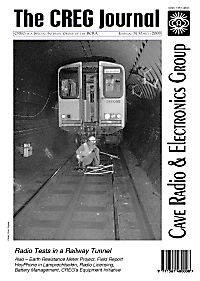
- The most recent issue to be published was 125
- For further information, please see Publishing/Despatch Schedule
- Database last updated on Wed, 03 Apr 2024 16:35:02 +0100
- Online access is currently available for all issues. Some of
the older issues are bit-map scans rather than digital copies.
journal scans.
- Online voting for CREG articles was withdrawn in June 2022. For info see
Voting for CREG articles
Contents of journal 51
March 2003
This page may take a few
seconds to load. Please wait ...
- CREG Journal
(PDF 2.1MB)
  Individual articles may be available below Individual articles may be available below
- Contents
-
- Newssheet
- Cave Radio Test Sites; CREG Award; HeyPhone PCBs.
-
- A Resistance Meter for Earth-Current Systems
- Measurement of the loop resistance of an earth-current system with a d.c.-based meter is not practicable because of the presence of d.c. potentials. John Hey describes an a.c. meter that gets round this problem.
-
- Radio Tests in Essex Road Railway Tunnel
- CREG was recently approached by Railtrack (now Network Rail) and asked to advise on management and safety communications for a casualty evacuation exercise in a railway tunnel. John Rabson reports.
-
- LF Propagation on Simulated Railway Tracks
- Propagation tests in tunnels have indicated that the tracks themselves may guide low frequency radio waves. As it is not always easy to get access to a railway line, some experiments have been performed above ground. John Rabson reports.
-
- Vision in Low-Lighting Conditions
- Previous definitions of scotopic or dark-adapted vision, used in the CREG journal, may have been wrong. David Gibson reports.
-
- Amateur Radio Licensing - an Update
- Over the past year more than 6000 of the new amateur radio Foundation licences have been issued. John Rabson, G3PAI, explains the new arrangements and why this development is significant for cave radio.
-
- Practical Battery Management
- How should batteries used for essential rescue equipment be stored? Mike Bedford gives some advice on battery management in response to queries from the cave rescue community.
-
- Portable Fuel Cells to Replace NiMH and Li-ion Cells?
- Stephen Voller, of Voller Energy, became frustrated with the short life of the batteries in his mobile phone and laptop computer, so he set up a company to develop miniature fuel cells to replace them.
-
- Web Watch
- Another list of sites from Peter Ludwig.
-
- Check Your Resistors
- A cautionary tale by John Rabson.
-
- Wet & Dry
- Mike Bedford reviews some more items of rugged equipment - a laptop, a walkie-talkie and a camera.
-
- Matching & Output Impedance: A Common Fallacy? (16-17)
(PDF 247KB)

- We often hear about 'output impedance' and 'matching' but David Gibson suggests that the terms are misunderstood by many designers, and he makes proposals for specifying low-frequency power amplifiers.
-
- Cave Rescue Wish List
- Jopo asked the BCRC committee what new items of cave electronic equipment would be helpful to them.
-
- HeyPhone Testing in the Lamprechtsofen
- Fay Hartley of Four Iron Caving Club took two HeyPhones on a trip to Austria and shows that performing the actual testing can be less than half the battle.
-
- CREG's Equipment Initiative
- Mike Bedford describes how CREG is now starting to serve the wider caving community by loaning equipment and by providing PCBs for projects at cost.
-
- HeyPhone Documentation: More Updates
- Mike Bedford outlines new and updated documentation, which is available on the HeyPhone Website.
-
- Speleonics
- Lumileds Lighting, Flashgun Slave Unit and more. Contributions summarised by John Rabson.
-
- Piecewise Modelling of Antennas
- The NEC series of programs is used for calculating the behaviour of antennas. Brian Pease discusses his experiences with the latest version.
-
- Cave Radio Notebook
- 54: Noise Shielding, 55: Measurement of V & I at LF. 56: Specific Aperture. Column edited by David Gibson.
-
- Making Sense of Atmospheric Noise Temperature Ratio
- The often-quoted CCIR noise data is probably irrelevant for predicting the performance of equipment with magnetic loop antennas. David Gibson explains why.
-
- Letters to the Editor
- Letters.
-

|

View Contents:

BCRA is a UK registered charity and is a constituent body of
the British Caving Association,
undertaking charitable activities on behalf of the BCA.
BCRA publishes a range of periodicals and books.
Click here for further information.
|
Searching
To Search our pages using Google, type a search
string in the box at the top of the page and hit your Return key
You can also search our publications catalogue at the British Caving Library
The CREG Journal Search Engine is a new, powerful search engine which will, sometime, be extended
to cover Cave & Karst Science. We have a keyword search facility on our Cave Science Indexes pages but this may be rather out-of-date.
|
For staff use: Link to Database
Show/Hide
download figures next to each item (if available and non-zero; you might need to refresh page first). Counters last
reset on Thu 03-Jan-2019 17:29:28 +00:00. The figures are non-unique
click-throughs.
|








